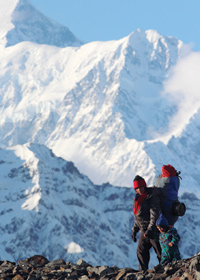Great Expeditions with Ground Truth Trekking

Husband and wife scientists Bretwood Higman and Erin McKittrick do not go on vacations. Their day-to-day lives are an adventure—with a Mongolian yurt lacking running water or a toilet in remote Seldovia, Alaska, serving as home to the couple and their two young children and regular treks across the Alaskan wilderness an integral part of family life. They dubbed their most recent family expedition “Life on Ice”—two months exploring the edge of Alaska’s massive Malaspina Glacier in the fall of 2011 with 2 1/2-year-old son Katmai and 8-month-old daughter Lituya. They brought an inflatable raft, a woodstove, a small electric bear fence and clothing, gear and biodegradable diapers to last the family for two months of outdoor living on the edge of the Earth. Along the way, they documented signs of climate change in the altered landscape and recorded their adventures for a blog on the website of their nonprofit Ground Truth Trekking.

Witnessing Change
“The entire vast landscape of the glacier and around the glacier is changing very rapidly,” says Higman, known to all as Hig. “Beaches are eroding, lakes draining, new forests popping up, while others that grow atop the glacier itself are crashing into gaping holes as the ice melts. New lakes and long-buried islands emerge from beneath the edge of the ice along with streams that are being colonized by salmon. One of the most subtle changes is that the ocean is increasingly gaining access to the glacier. This process, as it heads toward its inevitable conclusion, will lead to retreat rates and changes in the landscape far more dramatic than what’s happening now.”
The couple founded Ground Truth Trekking to better communicate the impact of climate change to the public via first-hand accounts, stunning photographs, videos and scientific assessments (he has a Ph.D. in geology; she, a master’s in molecular biology)
“We’re scientists, and we love the academic study of issues like climate change, environmental degradation, externalities and resource depletion,” Hig says. “But these seem abstract until you go out and run into them head-on. We pick our trips to put us where we expect we’ll learn new stuff. But we always learn things we never expected. And I think when we share our stories with others that they are able to experience some of that tangible reality through us. ”

Trekking with Kids
Trudging across Alaska’s “Lost Coast” with young children is not for everyone. But Hig says it’s not nearly as dangerous as it seems, though conditions can change suddenly. Their fall trek exposed them to torrential rains and driving wind storms. A tent and space heater (weighing about six pounds) were essential to provide a warm escape.
But, Hig says, “In most ways the severity of conditions is more about discomfort than danger.” That said, bears are a real worry. “Bears are in most ways scarier than they are dangerous, but I think that the vulnerability of children, both actual and in terms of how the bear perceives them, adds to the very low risk. This makes us nervous, but I think that the risk is no higher than other risks our culture finds more acceptable, like driving with children in the car, or living near particulate sources that incur long-term cancer risk.”
And those extreme conditions come with moments of extreme, breathtaking beauty. The icy peaks glow pink, the surf orange, in the day’s low light; majestic white peaks rise in the distance; massive waves crash on a rocky shore; sea lions bask in the sun.
When possible, the couple includes stops with local families in their travels—experiences that have introduced them to people, that Hig says are “far outside our normal experience in terms of culture and politics.”
It’s one way to connect to the broader world while still disconnecting from its trappings. On a larger scale, they offer a vision of what’s possible in traveling with kids—nearly anything.
“I think that the hard part is getting past the limitations and expectations of the parents,” Hig says. “Young kids don’t know any better—they’ll see all manner of strange new places as just the way things are and adapt beautifully. There are some big details to deal with still, like how do you carry enough stuff? And how do you make sure the kids are safe? But I think it’s far more possible to do great expeditions with kids than most people realize.”

